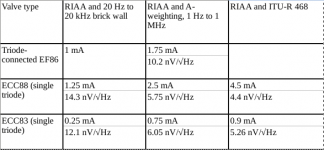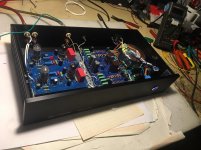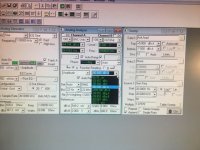The input capacitance is listed 6,9 pF for 6S3P.....
PS: a little doubt about the indication of input capacitance, I assume it is Cag.
The input capacitance on a triode amplifier is more or less the combination of Cg-k and Miller capacitance ( which is more or less Ca-g x A).
To measure capacitance we use a tre way rotary switch to select the appropriate value of cap, this box is connected in series with input and the frequency is 20 kHz. We we read the half value on input terminal we got the real value of Cin
That is one possibility to determine input capacitance, but not the only.
Basically the more one knows about electronics and measuring principles, the more ways he has to get right answer.
I found another data sheet where is clearly wrote the Cag it is 2,2 pF
http://www.sovtube.com/pdf/6S3PE.pdf
now is clear.
The method we use in Audioreview lab is the most accurate to get the results also because these data are published.
Walter
http://www.sovtube.com/pdf/6S3PE.pdf
now is clear.
The method we use in Audioreview lab is the most accurate to get the results also because these data are published.
Walter
Here is my version with hi-gm triodes 6S3P-EV. These produce some 6...7 dB better signal to noise ratio compared to typical 12AX7/ECC83 constructions.
Gain is 40,3 dB, noise level at the input is 0,75 µV when terminated with 50 ohms.
THD = 0.08 % at 1 Vrms out.
According to measurements that Merlin Blencowe once published in an article in the Journal of the Audio Engineering Society, the ECC83 is remarkably good noise-wise despite its low transconductance. Its 1/f noise is quite low.
Standard the termination at the input for MM is 600 ohm ( I believe is an international rule, not sure).
Although it usually doesn't matter much with valves, it's very unfortunate that moving-magnet amplifier noise is often measured with a 600 ohm resistive source. Over most of the audio band, a 600 ohm resistive source isn't even close to the magnitude of the impedance of a moving-magnet cartridge with its inductance of 0.5 H or so. As a result, the impact of current noise is much less than with a real cartridge. When the input stage consists of a bipolar transistor and you optimize the amplifier for minimal noise with a 600 ohm source, you end up with a much higher collector current than is optimal with a real cartridge. Nonetheless, record surface noise usually still dominates when a record is playing.
Last the comparision on 12AX7 must be done with same gain so you can get the value of input noise reading the output noise / gain, with 22-22kH bw and weighted A , as international rules.
Good point as with valves, there is a different noise optimum depending on the type of weighting. The white noise goes down with increasing anode current, but the 1/f noise goes up. With A-weighting, 1/f noise has much less impact than without it, and you end up with a higher optimum anode current.
Based on Merlin Blencowe's data for the ECC83 and ECC88 and my own measurements on a very small number of triode-connected EF86's, I once found the attached table. The noise density is a sort of average, to be precise it is the amount of white noise voltage at the input of the amplifier that would produce the same total noise at the output of the weighting filter as the actual noise of the valve.
The optima for A- and RIAA-weighted noise correspond to 0.35 uV for the ECC83, 0.33 uV for the ECC88 and 0.58 uV for the triode-connected EF86 when you divide the total weighted noise by the gain at 1 kHz.
Attachments
Last edited:
To prevent misunderstandings: you can't compare the values from my last sentence 1 to 1 with artosalo's 0.75 uV because the weightings are different.
I won't reffer specifficaly to the valves you used in your circuit, but i tried simillar circuits based on D3a and i found that using infrared LED's in the cathode makes the distortions audible and not pleasant at all compared with the simple cathode resistor versions.Here is my version with hi-gm triodes 6S3P-EV. These produce some 6...7 dB better signal to noise ratio compared to typical 12AX7/ECC83 constructions.
Gain is 40,3 dB, noise level at the input is 0,75 µV when terminated with 50 ohms.
THD = 0.08 % at 1 Vrms out.
Now i can simply understand the decision for using an LED for biasing the valves as they are lower gain than D3a or 12AX7 and the noise is also lower with an LED so maybe using a cathode resistor would make the total gain unfit for a line output usual level, but distortionwise i can bet you can hear the difference between resistor and LED bias.
LED bias worsens the EIN compared with resistor bias, unless you bypass the LED with a large capacitance (100uF is usually enough)
Hi
In attach the photo of the proto of Junior assembled.
The tubes are 5965 in gain stage + PCC88 output.
In addition the test on s/n on this version.
the gain is around 109, 40,8 db
the s/n measured is 80,68 with a residual of 50,78 uV. Weighted.
It is very good.
The noise tension related to the input will be 50,78 /108 = 0,47 uV.
The 5965 is not a very high gm tube ( but it has a reasonable low Rp) but in this configuration it is very impressive also as sound.
In other project I got, with a pentode configured as triode, around -85 dB weighted.
The way of pentode configured as triode is fine with one problem, microphonic!
In attach the photo of the proto of Junior assembled.
The tubes are 5965 in gain stage + PCC88 output.
In addition the test on s/n on this version.
the gain is around 109, 40,8 db
the s/n measured is 80,68 with a residual of 50,78 uV. Weighted.
It is very good.
The noise tension related to the input will be 50,78 /108 = 0,47 uV.
The 5965 is not a very high gm tube ( but it has a reasonable low Rp) but in this configuration it is very impressive also as sound.
In other project I got, with a pentode configured as triode, around -85 dB weighted.
The way of pentode configured as triode is fine with one problem, microphonic!
Attachments
- Home
- Amplifiers
- Tubes / Valves
- Pure tube phono preamp kit


